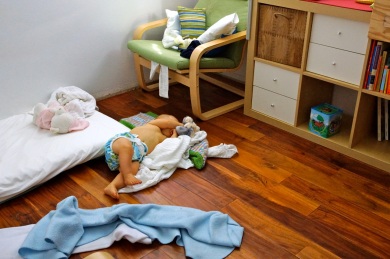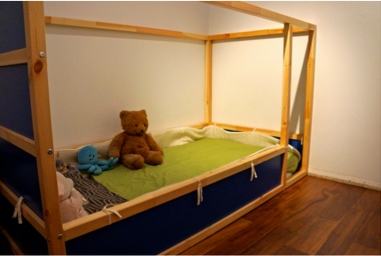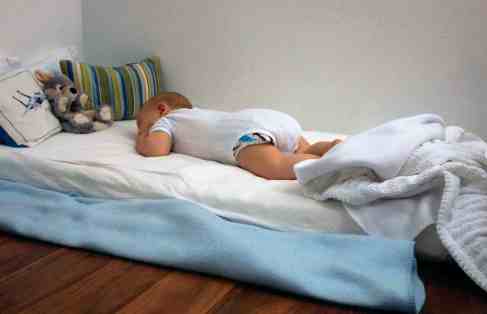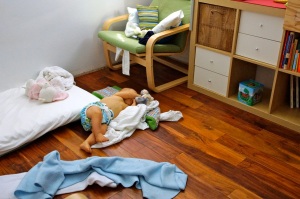It seems like there are two major complaints when it comes to using a floor bed: the baby rolls off while sleeping and/or the baby crawls off to explore the room instead of staying put and falling asleep. I’ve experienced both situations, and I hope that I can provide some encouragement and realistic expectations for parents going through the same scenarios. Because the truth is, when used correctly, the floor bed is an amazing tool for supporting your child’s development, both mental and physical.
Before we get to the solutions, let’s discuss the main purposes of the floor bed: encouraging independence, allowing the development of the child’s will, and supporting their need for movement. A child on a floor bed can get in and out on her own as soon as she can slither, thereby reducing her dependence on adults and increasing her sense of self-reliance. This experience supports the development of the will, wherein the child formulates a goal, tries different strategies, accomplishes her mission, and feels successful. And all the while, her need for free movement is being supported, because she can use each skill (focusing her eyes, rolling, slithering, crawling) as soon as she develops it.
Like any other Montessori developmental aid (including mobiles, weaning table & chair, and every single Montessori material), it is important to introduce the floor bed at the right time. Failure to do so can result in reduced effectiveness and increased frustration for both parent and child.
The best time to introduce the floor bed is a few weeks after birth. At first, the newborn should sleep in a bassinet that allows unobstructed views of her surroundings. However, around the time that recognizable sleep patterns are established and before the child is rolling, she should transition to the floor bed. Each child and each family is different; you can read about how I transitioned my son from the bassinet in our room to the floor bed in his room here.
Transitioning your child at the right time doesn’t mean that you won’t encounter challenges. Once your baby starts rolling, chances are she’ll probably roll off the floor bed at some point. This seems like a bad thing, but consider it from your child’s viewpoint: she’s free to move and practice her new skill; she’s developing an awareness of borders (which will come in handy when she navigates stairs and transitions to a “big kid bed”); and she’s experiencing the consequences of moving past those borders. 
Many families find that a soft rug or blanket placed just next to the floor bed is all that’s needed to cushion the baby’s “fall” (which in reality is not more than a few inches). Some parents find that they can gently move their baby back to the bed without waking them, while others (like me) prefer to let the baby snooze on the floor. If your child is particularly active while sleeping (like mine is), and she’s at the stage where she’s able to slither on and off her mattress at will, you can also try placing a rolled towel at the edge of the bed under the fitted sheet, or investing in the wonderful IKEA Kura loft bed (minus the slats, so the mattress rests on the floor). This set-up won’t hinder a child’s independence as long as you show her how to get in and out, and will provide the support they need to stay on the mattress. 
The more stressful challenge to parents is when the child starts slithering and decides to move off the bed to explore her room, instead of staying in bed and falling asleep. While frustrating to adults, we must remember that this is exactly what the floor bed is designed to do – encourage independence and develop the will. You can read here about what happened when we decided to follow our child’s lead.
The best piece of advice I can give parents who are going through this phase is to keep their child’s room as sparse as possible. On the shelves the child can reach, place only a few carefully selected items for her to explore and leave them there, always in the same order. Don’t make the bedroom her activity or play area or feature lots of new and interesting objects at her eye-level, because this will encourage her to get out of bed and go see what’s new. She will certainly crawl out when she first develops the ability to do so, but once the novelty fades, if there’s nothing new for her to explore in her room she’ll be more interested in resting (because all that slithering and crawling is exhausting!).
Many parents make the transition from crib to a floor bed after the child is slithering or crawling, expect them to just stay put and fall asleep, and feel frustrated when this doesn’t happen. When a young child is given freedom, she’ll use it to further her development. She can’t not. It’s an evolutionary mandate. If you’ve chosen to give your child the freedom to move, then you can’t be angry at them when they take full advantage of it! Be patient, provide a predictable routine and clear expectations, and gently re-direct back to the bed as many times as necessary each evening. I assure you that with consistency and realistic expectations will come success, and your child will reap the long-term benefits of the floor bed!








